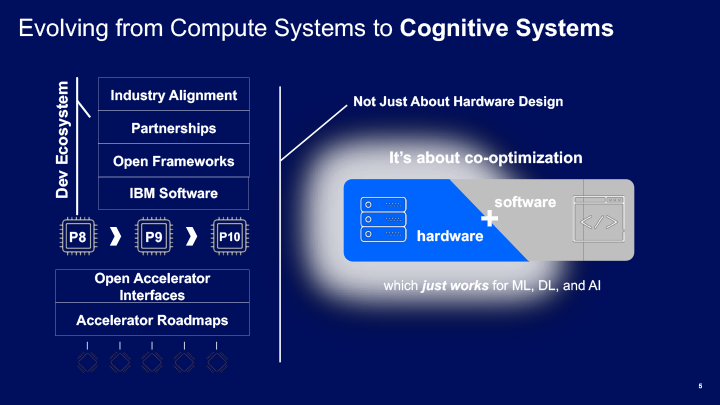Ron Gordon
Director » Power Systems
Recently, I have been in several IBM sessions where the IBM Power Systems, now known as Cognitive Systems, has presented their strategy. As many of you have not had the opportunity to be at an IBM Cognitive Systems presentation regarding their strategy, I thought I would share this with you, along with some of my comments.
IBM Cognitive Systems Strategy
The overall strategy is composed of four areas of investment:
- Industry leading technologies and accelerators
- Open ecosystem
- Co-optimized software and hardware
- Cloud deployment options
Let’s look at each of these areas:
Industry leading technologies and accelerators
Cognitive Systems definitely leads this area today, and in my opinion, will continue to lead in support of evolving workloads, like AI and HPC. This will be done by using technology advancements to improve existing mission-critical work in the area of data base and transaction processing performance, with security built on higher resiliency in POWER-based systems and being utilized by changes in AIX, IBM i and Linux. Today’s advanced AI and HPC applications are changing business, with more insight and faster results. Without POWER9 performance and integration of accelerators, like the Nvidia GPUs, we would be at a stagnation point. With computational capabilities up to 54x, new insights can now be gained. IBM is clearly investing in these areas and is starting to discuss changes to increase the POWER9 bandwidths and NVlink performance. And, IBM is discussing POWER10 (which is in the future) and promises even higher performance thru the integration, connectivity, and exploitation of GPUs, FPGAs, ASICs, and evolving PCIe standards.
Open ecosystem
Again, IBM is already a leader here and participates in several consortiums and open source development. Two examples are Open Power and Open CAPI consortiums. Through these working groups of over 300 members, IBM is sharing technology and intellectual information so that advancements, which cannot be done by single enterprises, can be commercialized. A couple of examples are the integration of Nvidia GPUs with POWER processors, and the Open CAPI SNAP development environment. Also, this co-operative approach has enabled the availability of the LC POWER9 low cost, high performance line of servers, specifically for clustered HPC. I see more products and integration of capabilities, like Storage Class Memory and PCIe-4 adapters in the future, based on the Open approach and the participation Cognitive Systems is undertaking.
Co-optimized hardware and software
Without this key tenant, software would not be able to take advantage of the capabilities that POWER systems enable. SMT8, RAS and resiliency are hardware capabilities, but application software must be aware of these functions, or they have no value. With open source software development, like the Linux kernel, IBM development teams in the LTC are making code available that will enable Linux to exploit these POWER capabilities and provide differentiated value for Linux applications. Also, as open source applications are becoming more relevant, such as the Mongo database, IBM and Mongo co-operatively optimize the POWER version of Mongo to provide support of the POWER9 advanced capabilities. The example of POWER-based systems and Nvidia GPUs is an obvious example of co-optimization of hardware, through the advanced capabilities only available on the AC922 Power System of Large Memory Model and Distributed Deep Learning support.
Cloud deployment options
Cloud is key in all IT organizations. Cloud strategies and implementations can be public, private or hybrid. IBM Cognitive Systems is actively investing in all three areas. In private cloud products, such as PowerVC (based on OpenStack) and IBM Cloud Private (based around Kubernetes), working with PowerVM provides a good base for on-prem clouds. At the same time, (using co-optimized software) these run alongside an x86 environment and have a high-level end user interface through VMware vRealize. In hybrid, the ICP product can also deploy to public clouds for the best each has to offer. And, if one wishes a pure public cloud, IBM also has offerings in managed services.
So, those are the pillars of the Cognitive Systems strategy, as I see it. There are many more words, as well as examples, as to how these strategies are also products and in-plan advancements. I also like this single image of the Cognitive Systems strategy:

Please contact your Mainline Account Executive directly for additional information, or click here to contact us with any questions..
Related Blogs:
IBM Power Systems upgrade High Performance Systems for Cognitive and AI workloads
Cognitive Computing & IBM…What Is It All About and Why Should I Care?
IBM Power Systems for AI Advanced Analytics – Getting Started

